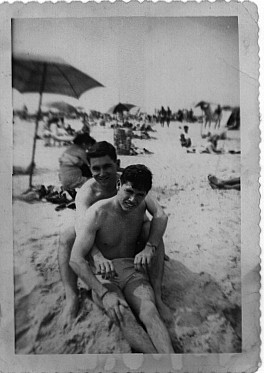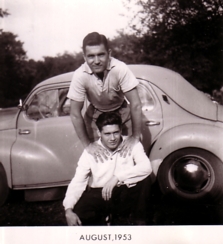

Partner Warren Allen Smith
Queer Places:
31 Jane St, New York, NY 10014
 Fernando Rodolfo de Jesus Vargas Zamora (September 22, 1928 - February 20, 1989) was the son of Manuel Elias Vargas Cordero, a department store owner, and Elena Zamora Paniagua. Fernando was the last-born. Raised a Catholic, Vargas renounced Catholicism when as a teenager he left Costa Rica. When 16 and a student at Colegio Los Angeles in San José, Vargas earned his best grades in biology and history, his weakest in religion and English.
Fernando Rodolfo de Jesus Vargas Zamora (September 22, 1928 - February 20, 1989) was the son of Manuel Elias Vargas Cordero, a department store owner, and Elena Zamora Paniagua. Fernando was the last-born. Raised a Catholic, Vargas renounced Catholicism when as a teenager he left Costa Rica. When 16 and a student at Colegio Los Angeles in San José, Vargas earned his best grades in biology and history, his weakest in religion and English.
His father owned a large department store, in which he worked and was allowed to handle money. His youth was spent excelling in sports, riding a bicycle, visiting relatives in Cartago, Heredia, and Alajuela, and spending time near Teatro Melico Salazar and the Parque Central, the park on Calle 14 that he knew the best.
His hard-working mother supervised several servants and looked after her large family. When her husband died, a big tomb was constructed at Cementerio Obreros, for he was an important person who once had dreams of becoming President. On 3 May 1946, at the passport office Fernando received his passport and on 22 May 1946 he, his sister Elena, and his mother arrived in Miami.
When he was 8 months older than 17, Vargas arrived at 175 Claremont Avenue, New York City. His mother, sister, and he lived in a one-bedroom apartment between 123rd and 125th Street near the International House and the Manhattan School of Music. It was just west of Harlem, and he and his sister were not allowed to walk in the neighborhood, which their mother thought was dangerous. Little by little, they were allowed to go together around the immediate neighborhood. Much of his time was spent watching TV or going shopping with his sister for groceries or supplies. In the evenings they eventually got tired of supervising him and allowed him to go out alone.
He so met people who were Columbia University professors, students, and professional types. Also, as was the case at Parque Central near his home in San José, he noticed some younger and older males who were looking for sex. Although they were relatively rare at Parque Central, they were quite numerous in that section of Riverside Park. His first introduction to sex had been when he was an altar boy and a Catholic priest, who pretended it was accidental, touched his crotch.
Harold Bonilla, who was Costa Rica's consul in the city, accidentally met him in the park and asked him to move in with him nearby on 103rd Street. It was not difficult to obtain his mother's approval, for here was a person who wrote history books, was a Catholic, and mentioned that he might be able to get him a job and schooling. Now exactly 20, finding no jobs but not having to pay any rent, Vargas moved in. But when "Major" Bonilla was at work, Vargas hung out in the nearby Riverside Park.
Just up from 103rd Street one day in September 1948, he saw a college student sitting alone. The guy was friendly, said hello, and Vargas's response sounded to the stranger as if he were French. What transpired that day, the first week in which the stranger had arrived on the GI Bill to study English at Columbia University, is to be continued by Warren Allen Smith in a biography/autobiography of their 40 years together, one that is tentatively called In The Heart of Showbiz. Warren Allen Smith, whom he met soon after arriving in New York City, has in detail described their meeting and their forty years together.

Bonilla helped Vargas get a job in Manhattan's Garment District, one in which he used a sewing machine to stitch garments and was paid by the piece. But in 1949 Vargas moved from Bonilla's place with Smith to a furnished room on 109th Street. Smith now had earned his M.A. at Columbia - Vargas took a photo after Eisenhower handed him the sheepskin - and began teaching English at Bentley School on 86th Street.
He answered an ad for Vargas that led to his being interviewed by R. E. L. Lab, where he made a favorable impression on Edwin Armstrong after being coached about how to weld a certain item. Telling Armstrong he lived on 109th near Columbia, he learned that his boss taught there and in 1913 had discovered regeneration. With talk about amplifiers, feedback, and oscillators, the work turned out to be educational and enjoyable, particularly when Edwin - they soon were on a first-name basis - told of being paid only $1 by Columbia but was earning money from his patents.
He allowed the military to use royalty-free his findings about FM - frequency modulation - but when the war ended RCA claimed that they, not he, had invented it and they were suing each other. Edwin complained that he became nearly bankrupt from defending his patents, that his wife had left him in the middle of all this, and in 1953 his licenses and patents would all expire. He did not confide everything all at once, but on some days when agitated he would tell bits and pieces about having made the first portable radio and advanced AM radio and on other days he was like a friendly uncle. In 1954, Edwin dressed neatly, walked to a 13th story window, and jumped out. His body hit a third story overhang. Vargas was devastated. Later, Armstrong's wife settled with RCA for over a million dollars.
Vargas then studied electrical engineering at RCA Labs in Greenwich Village, West 4th and Greenwich Street, receiving a certificate in a year. When Major Bonilla told them that a 1 1/2 room apartment adjacent to his own on 103rd Street was vacant (and had once been lived in by a mistress of Costa Rican President Rafael Calderón Guardia), the two moved into their first apartment together.
Upon hearing from one of his many gay friends that Audiosonic Recording Studio was looking for someone who knew about electrical engineering, Vargas applied for the job at the Brill Building on Broadway and was hired as a temporary the same day by Bob Guy, the studio's owner.
By 1961, Audiosonic was floundering. Guy, the bi-sexual owner, was kiting checks and had put a prima donna trick on the payroll, Vargas complained. Fellow engineer Joe Cyr warned that they might all need to look for a job somewhere else. Vargas's and others' paychecks began to bounce and, at a quickly called meeting the owner said, yes, the place was bankrupt, he was sorry the paychecks were no good, and Eaton Factors that was owed money was going to shut the place down.
Cyr and Vargas, explaining this to Smith, suggested the three together might try to salvage the company by working with Eaton Factors. It was agreed that the three would be equal owners of a Sub-Chapter S corporation that would be set up. Space at Variety Arts, a major rehearsal building on 46th Street, became available. With many difficulties, the three not only founded Variety Sound Corporation but also included Guy as a partner because he had contacts with all the clients and would include Ad-Lib, his company that made radio jingles for stations.
In April of 1961, Variety Sound Corporation was formed. Smith and Vargas also started Variety Recording Service, a d/b/a that separated Variety Sound Corporation's recording income from Vargas's wholly owned dub-cutting business. The agreement with Guy included the stipulation that only Smith could sign checks, and eventually it was arranged that Guy would exchange his one-fourth interest in Variety Sound for his entire Ad-Lib company. With Guy no longer associated with the business, Variety continued profitably until Vargas's death in 1989.
To have lived a great life, no matter how long, is life's purpose, he believed. To that end he mastered acetate disks, using his own inventive modification of a Scully lathe and being one of the few in the Greater New York Area who could operate such a machine. Vargas produced a collector's LP of "Costa Rica's Caruso."
Vargas, who died six months after being diagnosed with having Kaposi's sarcoma in the lungs, was resigned to his condition and spent much of his final and painful weeks studying the latest developments in astronomy.
A portion of his cremated remains were scattered in the Hell's Kitchen and Times Square neighborhoods of New York City, where he had spent most of his life. Another portion was saved to be mixed with the remains of his companion of forty years, Warren Allen Smith. The bulk was returned to Costa Rica, where his remains are buried in the family tomb next to his father (Elias) and mother (Elena) at San José's Central Cemetery. In his honor, an Agua Buena support group was formed in Costa Rica.
My published books: